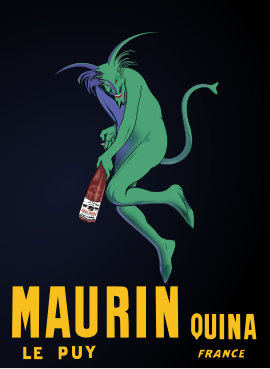
Leonetto Cappiello – Master of Bold Colour
Share
Poster Artist - Théophile Steinlen – Creator of the Iconic Le Chat Noir Poster
Leonetto Cappiello (1875–1942) was an Italian-French poster artist whose innovative designs revolutionized the world of advertising. Known for his bold colors, striking imagery, and ability to distill complex ideas into eye-catching visuals, Cappiello earned the title of “The Father of Modern Advertising.” This article delves into Cappiello’s life, artistic achievements, and enduring legacy while highlighting the cultural significance of his vibrant poster art.
1. Early Life and Artistic Beginnings
Leonetto Cappiello was born on April 9, 1875, in Livorno, Italy. Initially trained as a painter and caricaturist, he exhibited an early talent for capturing humor and personality in his work. In 1898, Cappiello moved to Paris, where he began contributing caricatures to magazines like Le Rire and L’Assiette au Beurre.
Though his caricature work earned him recognition, it was his entry into the world of poster design that cemented his place in art history. Inspired by contemporaries like Jules Chéret and Henri de Toulouse-Lautrec, Cappiello set out to redefine the advertising poster.
2. The Revolution of Modern Posters
At the turn of the 20th century, posters were becoming an essential medium for advertising, thanks to advancements in color lithography. While earlier poster artists like Jules Chéret focused on ornate, painterly designs, Cappiello took a radically different approach:
- Bold Simplicity: Cappiello’s posters featured uncluttered compositions that allowed the central image to stand out.
- Vibrant Colors: He used vivid hues to capture attention and create emotional resonance.
- Memorable Imagery: Cappiello often employed surreal or whimsical elements, making his posters unforgettable.
3. Iconic Poster Designs
Over his prolific career, Cappiello created more than 530 posters, many of which became cultural icons. Some of his most celebrated works include:
3.1. Péril Pétrolin (1909)
One of Cappiello’s most recognizable designs, this poster features a man leaping over flames with the aid of Pétrolin lubricant. The dynamic composition and fiery colors convey energy and excitement.
3.2. Maurin Quina (1906)
This poster for a French liqueur depicts a mischievous green devil holding a glass of the product. The devil’s playful expression and the bold contrast of green and red make this design unforgettable.
3.3. Chocolat Klaus (1903)
In this whimsical poster, a young boy rides a prancing horse while holding a box of chocolates. The bright, cheerful design exemplifies Cappiello’s ability to evoke joy and delight.
3.4. Cinzano (1920)
A vibrant depiction of two jubilant figures dancing with glasses of Cinzano, this poster radiates celebration and captures the spirit of the brand.
4. Themes and Techniques
4.1. The Central Figure
Cappiello often used a single, dominant figure as the focal point of his posters. Whether it was a devil, a dancer, or an animal, this central figure conveyed the essence of the advertised product.
4.2. Whimsy and Humor
Many of Cappiello’s designs incorporated playful or surreal elements. For example, his poster for “Bouillon Kub” features a chef juggling cubes of soup stock, adding a sense of fun to a mundane product.
4.3. Contrast and Color
Cappiello mastered the art of high-contrast compositions. His use of bold, flat colors against dark backgrounds created visual impact and made his posters stand out in busy urban environments.
4.4. Universal Appeal
Unlike some of his contemporaries who catered to elite audiences, Cappiello’s work was accessible and designed to resonate with the general public. His ability to simplify complex ideas into compelling visuals made his art universally appealing.
5. Legacy and Influence
Cappiello’s work transformed advertising and set new standards for poster design. His influence can be seen in:
- Modern Advertising: The focus on bold imagery and simple messaging remains central to contemporary advertising.
- Cultural Memory: Many of Cappiello’s posters have transcended their original commercial purpose to become celebrated works of art.
- Collectors’ Market: Original Cappiello posters are highly sought after by collectors and often fetch high prices at auctions.
6. Where to See Cappiello’s Work
6.1. Museums
- Musée des Arts Décoratifs (Paris): Home to a significant collection of Cappiello’s posters.
- Museum of Modern Art (New York): Features iconic works by Cappiello and other poster artists.
6.2. Online Resources
- Rijksmuseum Digital Collection: Offers high-resolution images of many vintage posters.
- Poster House: A museum dedicated to poster art, often showcasing Cappiello’s designs.
6.3. Collectors’ Market
Online platforms like 1stDibs and Artnet frequently feature vintage Cappiello posters for sale.
7. Relevant Links to Publicly Available Images
- Maurin Quina Poster: Maurin Quina by Leonetto Cappiello (Public Domain).
- Chocolat Klaus Poster: Chocolat Klaus by Leonetto Cappiello (Public Domain).
- Cinzano Poster: Cinzano by Leonetto Cappiello (Public Domain).
8. Caring for Vintage Cappiello Posters
If you are fortunate enough to own an original Cappiello poster, proper care is essential to preserve its beauty and value:
- Use Archival Materials: Store posters in acid-free sleeves or frames.
- Avoid Direct Light: Protect the poster from fading by using UV-filtering glass.
- Control Temperature and Humidity: Keep posters in a stable environment to prevent damage.
- Consult Professionals: For restoration or framing, work with experts experienced in handling vintage posters.
Conclusion
Leonetto Cappiello’s contributions to the art of advertising remain unparalleled. His bold, colorful posters captured the imagination of audiences in the early 20th century and continue to inspire designers and collectors today. By combining artistic innovation with commercial appeal, Cappiello elevated the poster to a true art form, leaving an indelible mark on the world of visual communication.




